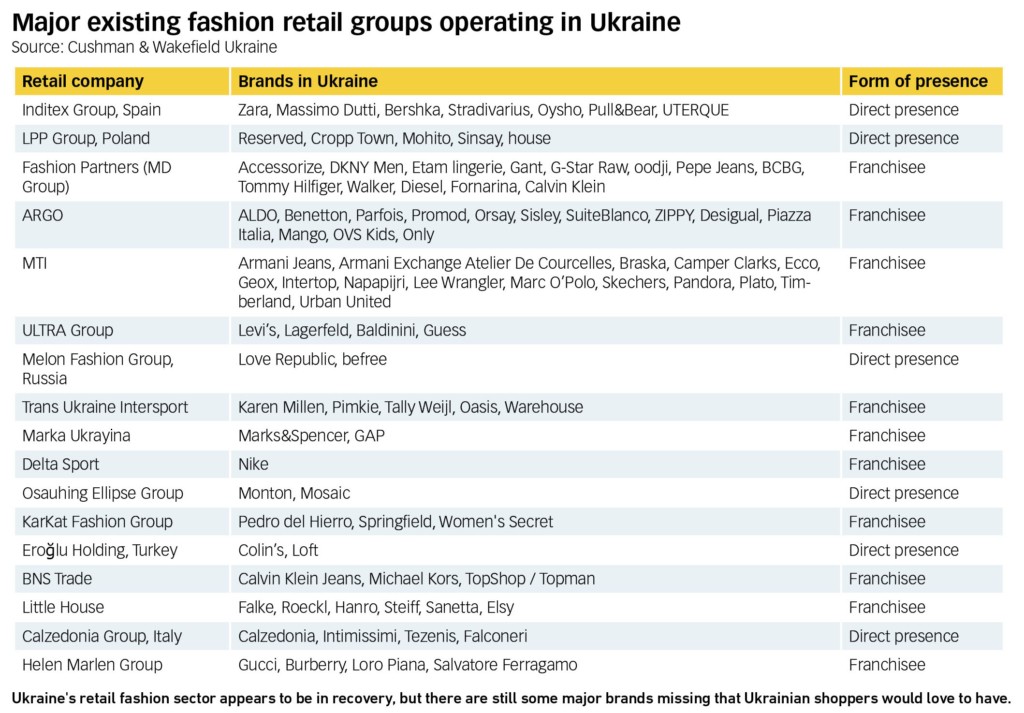During the 2014–2016 crisis, when the economy shrank by half and the currency lost two-thirds of its value, Ukrainians did not lose their urge to shop. But many in the nation lost their means.
That’s why international fashion brands haven’t been rushing to enter the market or increase their presence and why shoppers lack many famous brands to choose from. European and Turkish brands prevail, and most are selling via a franchise.
Russian fashion retailers, meanwhile, struggle for political and financial reasons. In 2016, Russian brands Kira Plastinina and Centro left the Ukrainian market.
Consumer spending
According to the 2016 Nielsen Global Consumer Confidence and Spending Report, consumer confidence in Ukraine has slightly improved. But it is still far from the level of most in Europe.
In 2016, 33 percent of Ukrainians reported not having disposable income after spending more than 60 percent of their monthly earnings on basic necessities, such as food, shelter and utilities.
In the first quarter of 2017, domestic retail sales in Ukraine were up 3 percent and amounted to $6.2 billion, according to the State Statistics Service.
However, in the clothing sector, sales were depressed; in May, retailers reported a 15 percent drop in sales, according to the Retailers Association of Ukraine.
So, like the rest of the economy, the retail clothing sector appears poised — or at least long overdue — for a rebound.
Risk or opportunity?
The expansion of the commercial real estate market, especially in Kyiv, opens new opportunities. There are about 50 malls in the capital today, according to Ukrainian Trade Guild. Together, they offer 1.2 million square meters of retail space.
However, experts say that the existing retail space isn’t sufficient for many international brands. Any international retailer looks to open several stores at once in order to lower the costs of logistics and management.
At the moment, the vacancy in the retail property market is at around 10 percent. It is expected to go lower as Lavina Mall, the largest in the country with 127,000 square meters of leasable area, fills up after its opening at the end of 2016.
Popular shopping centers with established reputations and high traffic are, naturally, short on available space.
If 10 more malls commissioned in 2017–2018 are built, they will add 600,000 square meters of retail space. However, in the past the opening of the malls was often postponed, sometimes for years. In 2016, only three new malls opened.
Even with all the new retail space, the Ukrainian market remains too volatile for some international brands.
“When international brands consider a new market, they make assessments for five to 10 years. In Ukraine everything — legislation, economy, government — changes too often, and this volatility increases risks,” Marina Chernenko, head of the Retailers Association of Ukraine, says.
Finally, Russia’s war in eastern Ukraine has forced some brands to put expansion plans on hold. Some of the largest cities, which normally would be considered by any international retailer, such as Kharkiv, Dnipro and Zaporizhzhya, are close to the conflict zone.
Tetiana Khoma, senior retail agent at Kyiv office of Cushman & Wakefield consultancy firm, believes that new international retailers should take advantage of the instability now.
“It’s the best time to enter Ukrainian market because now it’s the tenants who set the rules. The economy is improving, and in one or two years it won’t be as easy to negotiate favorable conditions with landlords,” she says.
New entries
According to CBRE 2016 report “How Global Is the Business of Retail,” Kyiv ranked 13th among 166 cities with 25 new brands that entered the market in the last year. In comparison, the leader, Hong Kong, saw 87 new brands.
So far it is hard to tell whether 2017 will bring more new brands, Tetiana Khoma of Cushman & Wakefield says.
In the first six months of 2017, a few new brands appeared on Ukrainian market such as Italian women’s clothing, shoes, and bags brand Liu Jo, another Italian clothing brand Xetra and Swiss lingerie brand Hanro.
One of the confirmed entries for this year is sporting goods brand Decathlon from French retailer Auchan Group. The store will be located in the new Rive Gauche mall on Kyiv’s left bank.
Some new franchises are on the way too.
Ultra Group introduces British clothing brand Superdry. ARGO brings Italian PINKO and Dutch Scotch & Soda. Inditex Group expands Stradivarius brand with a men’s clothing line. Helen Marlen premieres Calvin Klein.
Turkish brands DeFacto and Koton are in the process of negotiation with two Kyiv malls without a particular date for entry. Flo and Collezione reportedly also consider entering.
Expansions
Existing retail chains constantly seek to expand their network of stores, too. Those announcements came from Inditex Group, LPP Group, New Yorker, LC Waikiki, Jimmy Key, and Arber. In addition to the physical store network, retailers develop their online sales in order to create omnichannel shopping experience for consumers.

Ukraine’s retail fashion sector appears to be in recovery, but there are still some major brands missing that Ukrainian shoppers would love to have.
